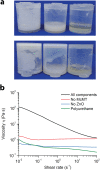Bioinspired mechanical mineralization of organogels
- PMID: 38097549
- PMCID: PMC10721619
- DOI: 10.1038/s41467-023-43733-x
Bioinspired mechanical mineralization of organogels
Abstract
Mineralization is a long-lasting method commonly used by biological materials to selectively strengthen in response to site specific mechanical stress. Achieving a similar form of toughening in synthetic polymer composites remains challenging. In previous work, we developed methods to promote chemical reactions via the piezoelectrochemical effect with mechanical responses of inorganic, ZnO nanoparticles. Herein, we report a distinct example of a mechanically-mediated reaction in which the spherical ZnO nanoparticles react themselves leading to the formation of microrods composed of a Zn/S mineral inside an organogel. The microrods can be used to selectively create mineral deposits within the material resulting in the strengthening of the overall resulting composite.
© 2023. The Author(s).
Conflict of interest statement
The authors declare no competing interests.
Figures




References
-
- Ji D, Kim J. Recent strategies for strengthening and stiffening tough hydrogels. Adv. NanoBiomed. Res. 2021;1:2100026. doi: 10.1002/anbr.202100026. - DOI
Grants and funding
- COE 5-29168/United States Department of Defense | United States Air Force | AFMC | Air Force Office of Scientific Research (AF Office of Scientific Research)
- CHE-1710116/NSF | Directorate for Mathematical & Physical Sciences | Division of Chemistry (CHE)
- W911NF-17-1-0598 (71524-CH)/United States Department of Defense | United States Army | U.S. Army Research, Development and Engineering Command | Army Research Office (ARO)
- DMR-2011854/NSF | Directorate for Mathematical & Physical Sciences | Division of Materials Research (DMR)
LinkOut - more resources
Full Text Sources

